It looks like you're using an Ad Blocker.
Please white-list or disable AboveTopSecret.com in your ad-blocking tool.
Thank you.
Some features of ATS will be disabled while you continue to use an ad-blocker.
share:
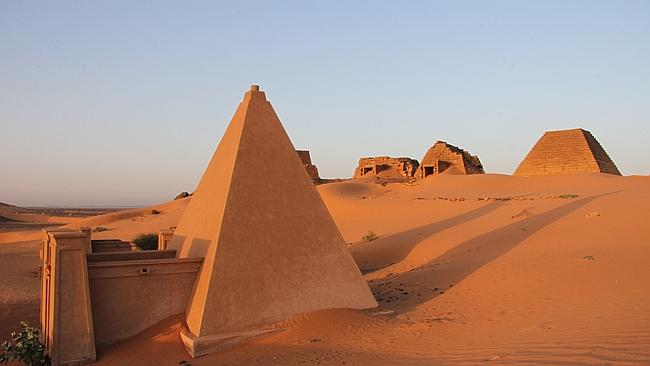
EGYPT isn’t the only African country with ancient pyramids rising from its sands. In fact, there are more pyramids in one small section of the northern Sudanese desert than there are in the whole of Egypt.
During Egypt’s 25th dynasty (760BC until 656BC), Meroe, now located in Sudan, was the capital of the Kingdom of Kush, ruled by Nubian kings who had conquered Egypt.
Often overlooked in the history books, these black pharaohs presided over an empire that stretched from the Mediterranean Sea to present-day Khartoum.
Here is an interesting little article which covers a topic posted here before. The question over the years here at ATS has been posted quite a few times. Were the Egyptian elites Black or White?
I always answered...
'Yes'
edit on 1-9-2014 by SLAYER69 because: (no reason given)
What the... I never seen pyramids in Sudan!
Then again I wasnt there to see the sights...
Great find... thanks for sharing!!! Great thread!
Then again I wasnt there to see the sights...
Great find... thanks for sharing!!! Great thread!
a reply to: SLAYER69
Whilst talking to the museum guy in the museum in Cairo he told us that the ancient Egyptians were made up of three groups of peoples, the Nubian. the ancient and the modern Egyptians who were separated by facial differences with the modern Egyptians having very much finer features.
As the trip was finishing I didn't get the chance to ask any more questions but the Nubian was an integral part of Egyptian society. I suspect that as they were bigger and much stronger than the other two types they were the stone movers etc and I would expect many to return to Nubia etc and they built their own pyramids as they had the nohow.
The Pharaohs had numerous wives gained through treaties so the interbreeding with other nations would have been the norm and with the huge trade traffic that went to and fro, people would have stopped off and stayed etc so I suspect the races had a fair amount of interbred p-opulation over time as the norm. Its the ones at the top of the chain that like to breed with like.
Whilst talking to the museum guy in the museum in Cairo he told us that the ancient Egyptians were made up of three groups of peoples, the Nubian. the ancient and the modern Egyptians who were separated by facial differences with the modern Egyptians having very much finer features.
As the trip was finishing I didn't get the chance to ask any more questions but the Nubian was an integral part of Egyptian society. I suspect that as they were bigger and much stronger than the other two types they were the stone movers etc and I would expect many to return to Nubia etc and they built their own pyramids as they had the nohow.
The Pharaohs had numerous wives gained through treaties so the interbreeding with other nations would have been the norm and with the huge trade traffic that went to and fro, people would have stopped off and stayed etc so I suspect the races had a fair amount of interbred p-opulation over time as the norm. Its the ones at the top of the chain that like to breed with like.
Wow Slayer, I never heard of this before! Thanks for bringing it to my attention!!
a reply to: Shiloh7
Thank you for sharing you personal experiences and information. It is very much appreciated.
 The Black Pharaohs
The Black Pharaohs
Thank you for sharing you personal experiences and information. It is very much appreciated.

An ignored chapter of history tells of a time when kings from deep in Africa conquered ancient Egypt.
In the year 730 B.C., a man by the name of Piye decided the only way to save Egypt from itself was to invade it. Things would get bloody before the salvation came.
“Harness the best steeds of your stable,” he ordered his commanders. The magnificent civilization that had built the great pyramids had lost its way, torn apart by petty warlords. For two decades Piye had ruled over his own kingdom in Nubia, a swath of Africa located mostly in present-day Sudan. But he considered himself the true ruler of Egypt as well, the rightful heir to the spiritual traditions practiced by pharaohs such as Ramses II and Thutmose III. Since Piye had probably never actually visited Lower Egypt, some did not take his boast seriously. Now Piye would witness the subjugation of decadent Egypt firsthand—“I shall let Lower Egypt taste the taste of my fingers,” he would later write.
edit on
1-9-2014 by SLAYER69 because: (no reason given)
Why did they make those buildings in that shape anyway?
Is the pyramid less susceptible to weather or somthing?
Very cool though, i didnt know about these in the Sudan, so good thread
Is the pyramid less susceptible to weather or somthing?
Very cool though, i didnt know about these in the Sudan, so good thread
That's not like the great pyramid tho. It has 8 sides not 4. Still cool little tomb they built there fore sure.
But it's not really compariable with the great pyramids. Still really nice craftsmenship of that limestone.
But it's not really compariable with the great pyramids. Still really nice craftsmenship of that limestone.
a reply to: SLAYER69
S&F Slayer, nice post!
Do you know if the pyramids in Sudan and the other regions were constructed in the same manner? The ones in the picture look like they are a bit more elongated, or a bit more steep on the inclines than the ones we see in Egypt. Perhaps it is the angle in the picture, but I was just curious if you knew or had more information on it.
If that's true, I would be curious as to the reason why?
~Namaste
S&F Slayer, nice post!
Do you know if the pyramids in Sudan and the other regions were constructed in the same manner? The ones in the picture look like they are a bit more elongated, or a bit more steep on the inclines than the ones we see in Egypt. Perhaps it is the angle in the picture, but I was just curious if you knew or had more information on it.
If that's true, I would be curious as to the reason why?
~Namaste
edit on 1-9-2014 by SonOfTheLawOfOne because: (no reason given)
a reply to: SonOfTheLawOfOne
They are steeper, yes. They are pyramids, but different cultures build things different ways. Those pyramids are also notably smaller than the Egyptian variety. They look similar but aren't the same because they weren't built by the same people or cultural group. Much like how Maya and Inca ruins look really similar but distinct from each other.
They are steeper, yes. They are pyramids, but different cultures build things different ways. Those pyramids are also notably smaller than the Egyptian variety. They look similar but aren't the same because they weren't built by the same people or cultural group. Much like how Maya and Inca ruins look really similar but distinct from each other.
originally posted by: sidhedarkness
a reply to: SonOfTheLawOfOne
They are steeper, yes. They are pyramids, but different cultures build things different ways. Those pyramids are also notably smaller than the Egyptian variety. They look similar but aren't the same because they weren't built by the same people or cultural group. Much like how Maya and Inca ruins look really similar but distinct from each other.
Many ancient society impressed by the great pyramids of Giza tried to copy them. The great pyramids are standing there before as long anyone can remember.... Ergo, some societies go as far to claim that the great pyramids belong to their culture.
edit on 1/9/2014 by zatara because: (no
reason given)
This is a decent picture showing the tide of time, these places would have been incredible to see there splendour.
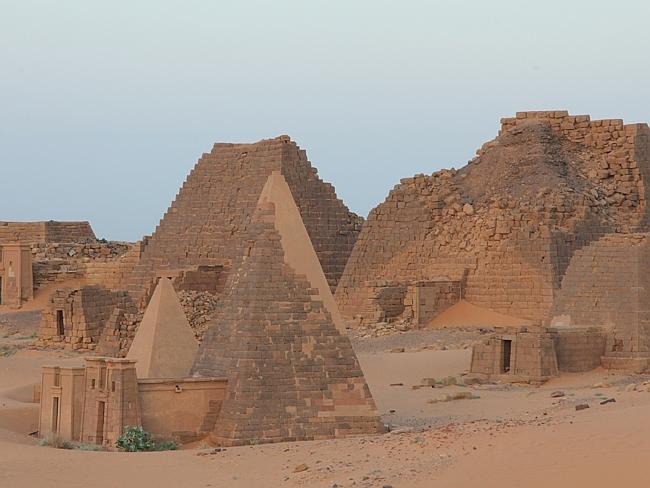
Unfortunately, not the hottest tourist destination at the moment

Unfortunately, not the hottest tourist destination at the moment
You can visit the Meroe pyramids via car ride and camel from Khartoum, but due to ongoing violence in Sudan, the Department of State currently advises against travelling to the country.
originally posted by: Biigs
Why did they make those buildings in that shape anyway?
Is the pyramid less susceptible to weather or somthing?
Very cool though, i didnt know about these in the Sudan, so good thread
Probably because vertical walls reflect light in all sorts of awkward directions when the Sun is low in the sky. And that pyramids are a more stable shape. Perhaps they reflected light so that people could navigate by them.
There was a large amount of trade going on - the Nubians mined the gold and sent the raw ore over to the Pharoahs in Egypt. In return their craftsmen would return gold trinkets and coins back to the Nubians - an early example of value-added features.
Even ziggurats have more stones or bricks in the bottom layer than the top. This form of stability in construction naturally lends itself to a pyramid
shape. Nothing special beyond good construction technique.
In modern times the skyscraper is symbolic of engineering prowess.
In modern times the skyscraper is symbolic of engineering prowess.
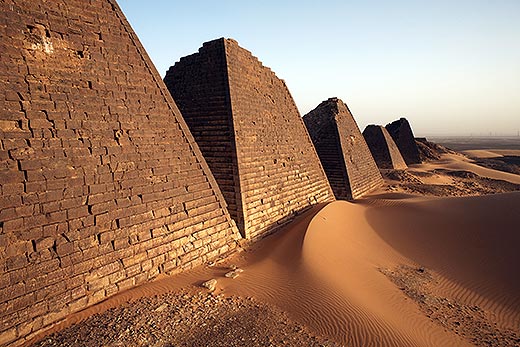
I am surprised that some respondents here haven't heard of the pyramids of Kush but knowledge do not necessarily reach us at the same time,so I am willing to bet if the pyramids of Kush were not known to many how about those of the Garamantians ,these were the ancient Saharan charioteers who raided and traded across the Sahara linking the coast with the interior they were also a pain in the ass to the Romans.


Pyramids Of The Garamantians.
The name of the Garamantes came from of the ahel Gara who had a town called Garama or Jerma. In ancient Greek myth, Garamas was a brother of Ogygia or Gyges a king in the Aegean and the grandson of Minos the ruler who founded Crete expelling the Carians a Pelasgian people from the area. The mother of Garamas, also called Amphithemis, was Tritonis, a water nymph. Interestingly the myth of descent from a water nymph seems to be retained among the people like the Fulani or Woodabe/Futa-be also once numerous in the neolithic Sahara and oases next to Egypt.
Garamantians peoples once had a major civilization in the Libyan Fezzan and Sahara comprised of several towns. The civilization peaked between the 2nd B.C. and 6th century A.D. From where the name of the Garama is derived it is not certain, but the direct roots of Garamantian culture date back to at least the 9th century B.C. and early Garamantians are described by Herodotus in the 6th century BC as a "great nation", although having no weapons of war.
Garamantian agriculturalists may have evolved from the neolithic agriculturalists of the region. By the time the Greeks first spoke of the them they were cattle herdsmen or pastoralists, but skilled in hydraulics and agricultural, metallurgy, glass-making and mining and used high-quality textiles. They had a well developed expertise in salt-refining as well. Their advanced irrigation and hydraulics technology allowed them to create a green oases in the midst of the Sahara. They had many walled towns and built pyramids and pyramid funerary monuments with Meroitic Nubian affinities. They were also noted as fishermen. Shrimp being among their favorite meals.
afroasiatics.blogspot.jp...
www.world-archaeology.com...
klik the links^
The Pyramid shape would manifest itself further south and west into the Empire of Mali
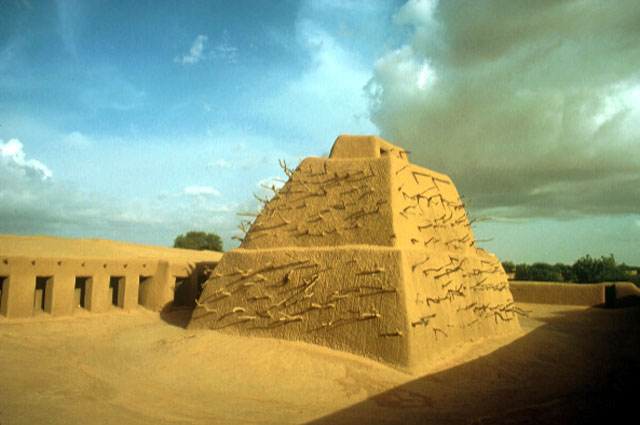
Tomb of Askia the Great of Mali there are others but this one is in better shape.
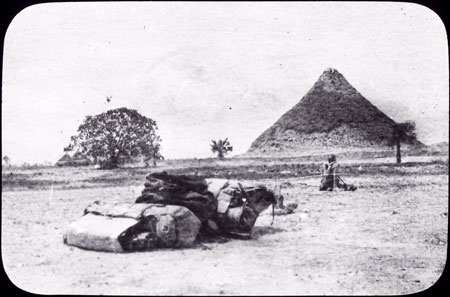
Often times some folk even here tried to denigrate people like the Dinka and the Nuer as being materially poor and naked barbarian cattle keepers who washed their faces with cattle piss and walked about in their birthday suites often compared negatively to the elegantly attired ancient Kemitians AkA Egyptian not knowing that the basic feature of Kemitian culture is very similar to these folks for it's from cow pokes like these with the sudbusters that gave rise to Nile Valley civilizations of Kush,Kemet and Ta-Seti,Axum
The 60-feet tall pyramid, surrounded at its base with numerous elephant tasks, was built in 1800s. By 1920s, the British administration attempted to destroy it leaving only about half of it intact.
www.southsudan.net...
edit on 1-9-2014 by Spider879 because: (no reason
given)
a reply to: sidhedarkness
Some believe they were there before the Egyptians themselves became an entity and that the Giza Pyramids/sphinx etc were built far back in prehistory.
For me the verdict is still out, I've often argued both sides.
Some believe they were there before the Egyptians themselves became an entity and that the Giza Pyramids/sphinx etc were built far back in prehistory.
For me the verdict is still out, I've often argued both sides.
a reply to: SLAYER69
I've heard some of those hypotheses, and I do give them some thought. The problem for me is that I haven't seen any evidence that really hints at the pyramids of Giza or the Sphinx being any older than we've already know them to be. I've also noticed many of these hypotheses are based off the assumption that humans weren't able to do the things they are reputed to have done some four thousand years ago... but somehow they could even further back. For me the logic in that doesn't make sense. Now, there are certain sites that do cause one to ponder, but I feel that a good chunk of our hypotheses about ancient Egypt and the pyramids (that aren't the mainstream) are so often built around a disregard for simple human ingenuity and fueled by the false belief that humans only got clever in recent history.
That being said, I do rather enjoy a lot of the fringe topics involving Egypt, and there are actually a few I could see being true. Not entirely, but at least in part. The Sphinx, for example, that's from the time of Khafre. There's really nothing to say it isn't. But that doesnt mean that there isn't something significant below it, or that it wasn't recarved from something else.
Unless you're talking about the Kušite pyramids. Those could be older than the Egyptians pyramids. I actually am not super familiar with those in particular, but as both those cultures interacted with one another heavily, I wouldn't be surprised if both developed their pyramids (and building styles, which look very similar) roughly at the same time give or take a couple hundred years or so.
Just my two cents.
I've heard some of those hypotheses, and I do give them some thought. The problem for me is that I haven't seen any evidence that really hints at the pyramids of Giza or the Sphinx being any older than we've already know them to be. I've also noticed many of these hypotheses are based off the assumption that humans weren't able to do the things they are reputed to have done some four thousand years ago... but somehow they could even further back. For me the logic in that doesn't make sense. Now, there are certain sites that do cause one to ponder, but I feel that a good chunk of our hypotheses about ancient Egypt and the pyramids (that aren't the mainstream) are so often built around a disregard for simple human ingenuity and fueled by the false belief that humans only got clever in recent history.
That being said, I do rather enjoy a lot of the fringe topics involving Egypt, and there are actually a few I could see being true. Not entirely, but at least in part. The Sphinx, for example, that's from the time of Khafre. There's really nothing to say it isn't. But that doesnt mean that there isn't something significant below it, or that it wasn't recarved from something else.
Unless you're talking about the Kušite pyramids. Those could be older than the Egyptians pyramids. I actually am not super familiar with those in particular, but as both those cultures interacted with one another heavily, I wouldn't be surprised if both developed their pyramids (and building styles, which look very similar) roughly at the same time give or take a couple hundred years or so.
Just my two cents.
edit on 9/2/2014 by sidhedarkness because: So... apparently the kingdom of Kush turns into a swear.
a reply to: sidhedarkness
The problem with the analysis of the Pyramid age is that they were taken from rock samples on the outside of the pyramid. We need to take the sample from the center of the pyramid and drill for a few dozen feet down to the base, where the first bricks were laid. Only then will we know when the pyramids were being constructed. For all we know the construction could have started 10000 BC and they just finished later on.
The problem with the analysis of the Pyramid age is that they were taken from rock samples on the outside of the pyramid. We need to take the sample from the center of the pyramid and drill for a few dozen feet down to the base, where the first bricks were laid. Only then will we know when the pyramids were being constructed. For all we know the construction could have started 10000 BC and they just finished later on.
a reply to: sidhedarkness
Good shout, the sphinx debate is that the head was re-carved to Khafres face (defacing previous Pharaohs was common in Egypt after all) which explains it's strange proportion. Some would say there is extreme water erosion on the sphinx's body and the wall surrounding it, but not the temple just next to it.
But you're right man, our human ancestors are not given enough credit for the work they did.
Good shout, the sphinx debate is that the head was re-carved to Khafres face (defacing previous Pharaohs was common in Egypt after all) which explains it's strange proportion. Some would say there is extreme water erosion on the sphinx's body and the wall surrounding it, but not the temple just next to it.
But you're right man, our human ancestors are not given enough credit for the work they did.
new topics
-
My given hammer and sickle avatar is getting boring.
Computer Help: 37 minutes ago -
ETX 125
General Chit Chat: 1 hours ago -
RIP Alex Salmond
Politicians & People: 3 hours ago -
Massive Petrol Station Explosion Throws Tanker 1,000ft Toward High Rise Building
Mainstream News: 5 hours ago -
Exploring Jupiter’s Ocean Moon - Europa Clipper Launch Window Opens on Monday
Space Exploration: 6 hours ago -
Conspiracies and Neurotiscism
Philosophy and Metaphysics: 6 hours ago -
Mob of up to 30 looters, some armed, ransack freight train in Chicago
US Political Madness: 8 hours ago -
The Curious Case of the Socialite Who Sterilized Her Daughter
Social Issues and Civil Unrest: 8 hours ago -
My Close Encounter of the First Kind
Aliens and UFOs: 10 hours ago
top topics
-
Mob of up to 30 looters, some armed, ransack freight train in Chicago
US Political Madness: 8 hours ago, 18 flags -
Conspiracies and Neurotiscism
Philosophy and Metaphysics: 6 hours ago, 8 flags -
Arthur, King of the Britons
History: 14 hours ago, 7 flags -
Massive Petrol Station Explosion Throws Tanker 1,000ft Toward High Rise Building
Mainstream News: 5 hours ago, 7 flags -
The Curious Case of the Socialite Who Sterilized Her Daughter
Social Issues and Civil Unrest: 8 hours ago, 7 flags -
Exploring Jupiter’s Ocean Moon - Europa Clipper Launch Window Opens on Monday
Space Exploration: 6 hours ago, 6 flags -
My Close Encounter of the First Kind
Aliens and UFOs: 10 hours ago, 6 flags -
RIP Alex Salmond
Politicians & People: 3 hours ago, 5 flags -
ETX 125
General Chit Chat: 1 hours ago, 0 flags -
My given hammer and sickle avatar is getting boring.
Computer Help: 37 minutes ago, 0 flags
active topics
-
Biden Harris DOJ Sues Virginia For Removing Non-citizens From Voter Rolls
2024 Elections • 67 • : theatreboy -
Looks like they are running with bird flu
Medical Issues & Conspiracies • 43 • : StoutBroux -
My given hammer and sickle avatar is getting boring.
Computer Help • 2 • : CosmicFocus -
My Close Encounter of the First Kind
Aliens and UFOs • 3 • : CosmicFocus -
Resources for Tracking EARLY VOTES As They Are Cast Nationwide - 2024 Presidential Election.
2024 Elections • 15 • : marg6043 -
How Communism and Marxism Were Introduced in the USA
New World Order • 125 • : BasicResearchMethods -
Massive Petrol Station Explosion Throws Tanker 1,000ft Toward High Rise Building
Mainstream News • 11 • : theatreboy -
Letting Migrants In and Prisoners Out -Starmer's British Utopia
Social Issues and Civil Unrest • 70 • : gortex -
Arthur, King of the Britons
History • 67 • : Justoneman -
ETX 125
General Chit Chat • 1 • : CosmicFocus
